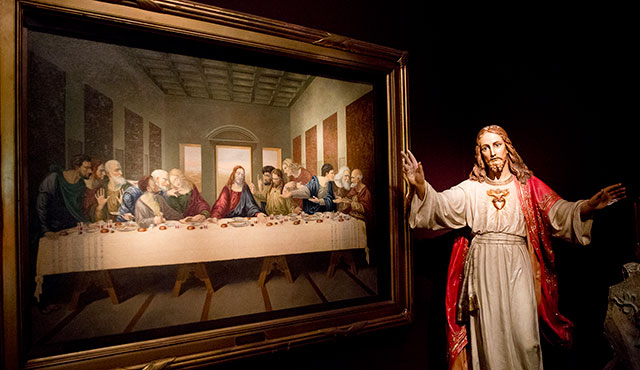When Catholics participate in the Eucharist at Mass, they partake of an ancient repast that has its roots in Jesus’s last meal. Knowingly or not, they also commemorate the very beginnings of Christianity – not to mention the birth of the priesthood.
In the New Testament, the apostles give eyewitness testimony that Jesus used the occasion of the Passover feast to transform bread and wine into His body and blood.
Fr. Christopher Smith, rector of Christ Cathedral Parish, says that when he tells the story of the Last Supper, he begins by asking, what happens when there’s a religious feast and some people want to be there, and some don’t?
“That’s the setting of the Last Supper,” he explains. “They come because He told them to.”
When Jesus says, ‘This is my body and blood to be given up for you,’ the apostles must have been puzzled, he notes. “But God the Heavenly Father saw that His son was giving His life for them,” Fr. Smith says, “and He decided that we are worth His son dying for. “
“When Jesus says that, He is telling them, ‘your life is worth my life,’” Fr. Smith says. Still, at that moment the apostles could not have understood the importance of what they witnessed. Upon Jesus’s resurrection, however, the meaning of the Last Supper became clear.
“Our beautiful Catholic understanding is that Jesus gave us the Church to celebrate and remember that Jesus gave his life for us,” Fr. Smith notes. “That’s what happens every time we celebrate the Eucharist.”
That is the ultimate meaning of the Last Supper to Christians: That Jesus said we are worth the price of His life. In Jewish tradition, Jesus’s direction to the apostles to ‘do this in memory of me’ creates the tradition for a ritual that must be performed again and again in His memory.
“When Catholics celebrate the Eucharist at Mass, we make present again what Jesus did,” Fr. Smith explains. “From this night, He said, ‘I empower you to transform this bread into my body and this wine into my blood for all who believe to celebrate and be nourished by.’” In addition, His words are taken to direct the apostles to become priests and spread the good news in His name.
Artists’ impressions of the last supper
Understandably the Last Supper has been a favorite subject of artists through the ages, writes Francis Mershman in Catholic Answers. “In the catacombs we find representations of meals giving at least an idea of the surroundings of an ancient dining hall,” Mershman says. “Of the sixth century we have a bas-relief in the church at Monza in Italy, a picture in a Syrian codex of the Laurentian Librar yat Florence, and a mosaic in S. Apollinare Nuovo at Ravenna.”
“The Last Supper” – the 15th-century mural painting by Leonardo da Vinci housed by the refectory of the Convent of Santa Maria delle Grazie in Milan – is one of the world’s most recognizable paintings.
The work is presumed to have been started around 1495–96 and was commissioned as part of planned renovations to the church and its convent buildings by Leonardo’s patron, Ludovico Sforza, Duke of Milan. The painting represents the scene of the Last Supper of Jesus with his apostles, as it is told in the Gospel of John, 13:21. In the work, Leonardo depicts the consternation that occurred among the Twelve Disciples when Jesus announced that one of them would betray Him.

